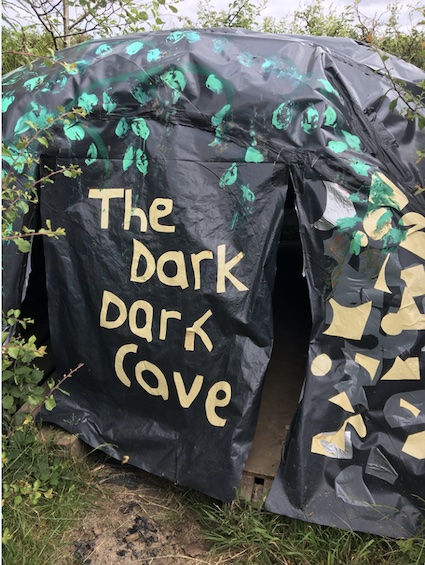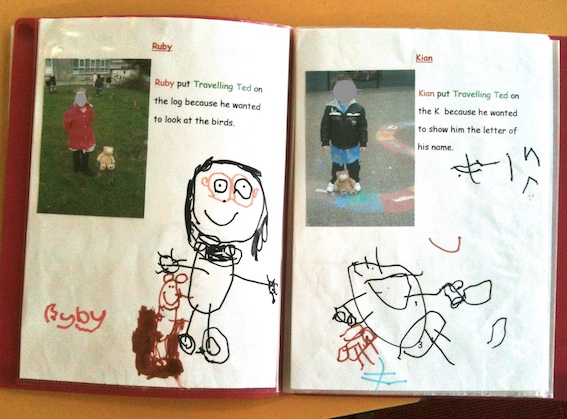Books are brilliant. They create worlds within our heads – places of power and possibilities. They feed our imagination and allow us to think “What if…?” As my friend, Dominic the Storyteller once told me, “Pictures tell a 1000 words, but stories create a 1000 pictures.“
World Book Day is traditionally celebrated on the first Thursday in March. To give you plenty of time to plan and prepare, I thought I would share 10 reasons why we need to get outside and celebrate the joy of books as a catalyst for outdoor activities.
1) People are reading everywhere
Go for a walk and look at the ways in which people are reading outdoors: street signs, shop windows, the hole-in-the-wall, newspapers on a park bench, Kindle on the ground, checking an app whilst getting from A to B or laughing at a text a friend has just sent. Discuss with your group or class the ways in which they most commonly read. Very often, children are unaware of the amount of reading they are inadvertently doing.
2) Different places add atmosphere to the reading aloud of any book
Years ago, at Sheldon Outdoor Centre, one member of staff had created a wonderful story told to the children around the campfire. The next day, she showed the group the shed where the character had been locked up. She would get them to track the unique markings made on the ground by the character’s gait. The story came alive as the children (aged 11yrs) worked like detectives to establish the truth of this person’s existence.

3) You can create a place-based genre
Try reading a beach book at the seaside; a book about birds in a hide or a story about eating vegetables in the veg patch. This makes for a good book sorting activity for children as they try and decide what book should be read where based upon its content. Have a look at a variation on this idea using a teddy bear for young children.
4) You can explore your local area through a book
Popular books like The Gruffalo or We’re Going on a Bear Hunt have inspired many families and classes to explore their local woodlands or grassland in search of such creatures. Where would the Gruffalo live near you and why?

5) Images or words can be connected to real objects
The more children know about the world around them, the more they can make sense of a text. It’s hard to imagine a lake if you haven’t seen one or touched, tasted and smelled water or heard the sound of the waves lapping on the shore. Books and the outdoor world have a symbiotic relationship. When out and about with young children, why not let them take photos of objects and use an app to create a digital book of their experiences?

6) Learn more about a favourite author or a place which inspired them
Beatrix Potter’s books are full of illustrations from the Lake District and you can visit her home, Hilltop Farm, near Hawkshead. Walk over the fells just as William Wordsworth and his friends did. Visit the lakes where Arthur Ransome based his Swallows and Amazons adventures. With a little research, a class could create a local map of book mentions! Another example is looking at all the places mentioned in the Harry Potter book series – remember maps can be quickly chalked on the ground outside for illustrative purposes (and maps involve reading signs and symbols).
7) Check what is happening at your local library.
Throughout the year, most libraries have a range of events and activities. Lots are for children but keep an eye out for adult events too. Keep families posted about these events through your school news channels.
8) Create an outdoor book festival
Each class chooses a book and listens to it being read outside and then undertakes an outdoor activity based upon that book. Open your events up to parents, family and friends. Blog or tweet about them so that other schools can learn from your experiences. A good starting point for ideas is the Creative STAR outdoor literacy page.
9) Re-visit how you use books in your outdoor space or school grounds
Follow the suggestions in the Reading Books Outdoors blog post. You may wish to develop Story Lines and Recycle Books for outdoor use.
10) Read for pleasure outside on World Book Day
The important thing here is to plan for the weather. So if it’s a cold, wet day, then perhaps a den building session is essential to building places where children can snuggle up with a good book. Have fleece blankets, quilts, cushions, sleeping bags and so on. Another option may be to have a hammock reading session – so have books available near a hammock. If you are skint, put a call out of big cardboard boxes – decorate these and turn them into mini reading boxes for use outside and in.
11) For more outdoor reading ideas to celebrate World Book Day, please check out the Love Outdoor Learning blog.
Finally, if you want a book to enthuse and inspire you to get outside with your class, then buy a copy of Dirty Teaching. Tell me which idea you liked the best, as it’s always interesting to know and get feedback. Thanks to everyone who has bought the book already 🙂

This blog post was originally published in October 2014.





























